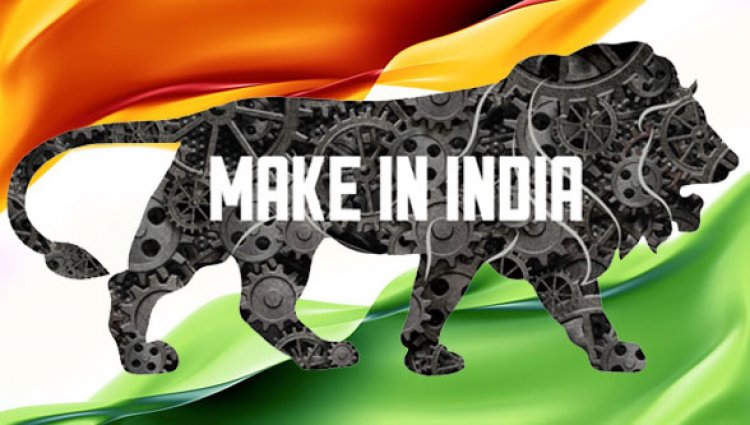Make in India Factual Analysis
On September 25, 2014, the project known as "Make in India" was introduced with the goal of encouraging investment, boosting innovation, constructing infrastructure that is the greatest in its class, and turning India into a centre for manufacturing, design, and innovation.

The Indian government places a high value on the growth of a competitive manufacturing sector as one of its top priorities. Make in India was one of the first projects to be a part of the "Vocal for Local" movement, which brought global attention to the realm of manufacturing in India. The industry has the ability to not only push the rate of economic growth to a higher trajectory, but also to employ a significant portion of our young labour force. This is a very exciting prospect. The Make in India project has made great progress and is now concentrating its efforts under the Make in India 2.0 banner on the following 27 industries.
• Aerospace and Defence
• Information Technology & Information Technology enabled Services (IT &ITeS)
• Automotive and Auto Components
• Tourism and Hospitality Services
• Pharmaceuticals and Medical Devices
• Medical Value Travel
• Bio-Technology
• Transport and Logistics Services
• Capital Goods
• Accounting and Finance Services
• Textile and Apparels
• Audio Visual Services
• Chemicals and Petro chemicals
• Legal Services
• Electronics System Design and Manufacturing (ESDM)
• Communication Services
• Leather & Footwear
• Construction and Related Engineering Services
• Food Processing
• Environmental Services
• Gems and Jewellery
• Financial Services
• Shipping
• Education Services
• Railways
• Construction
• New and Renewable Energy
LEGACY OF "MAKE IN INDIA"
1. Innovations in Procedures: The 'Make in India' initiative views the "ease of doing business" as the most crucial component in encouraging entrepreneurship. The business climate is improving thanks to the implementation of a variety of measures.
2. The government's new infrastructure plan includes building high-tech, well-connected, and environmentally friendly "smart cities" and "industrial corridors." A streamlined registration process and better infrastructure for IPR registration are beneficial to the innovation and research sectors. Finding out what kinds of skills are needed in the sector is the first step in training a new workforce.
3. There has been a significant increase in the availability of opportunities for foreign direct investment (FDI) in the fields of defence manufacturing, insurance, medical device manufacturing, building construction, and railway infrastructure. Foreign direct investment (FDI) is also permitted in the healthcare and insurance industries.
4. New Mindset: In order to partner with industry for the economic development of the country, the Government shall act as a facilitator and not a regulator.
WHAT ARE SOME KEY PROGRESSES MADE TO ENABLE MAKE IN INDIA?
1. Incentive plans tied to output: In the Union Budget 2021-22, it was announced that, beginning in fiscal year (FY) 2021-22, India will allocate INR 1.97 lakh crore (over US$ 26 billion) toward PLI schemes for 14 key sectors of manufacturing, in order to help achieve the country's goal of becoming Atmanirbhar and improve its manufacturing capabilities and exports.
2. National Logistics Policy and Prime Minister GatiShakti: To create a multimodal logistics infrastructure for national change, the government has launched a groundbreaking new programme: the Prime Minister's GatiShakti. Meanwhile, the National Logistics Policy was just released with the goal of cutting logistics expenses by about 10% over the next three years.
3. For the sake of both industrialization and urbanisation, the Indian government is working on a number of Industrial Corridor Projects as part of the National Industrial Corridor Programme, the ultimate goal of which is to create greenfield industrial regions/nodes that can hold their own against the world's premier locations for production and investment. 11 Industrial Corridors (32 Projects) across 4 Phases have been granted sanction by the Government of India. 2
4. India has approximately 79,100 startups and is the third largest tech-driven startup ecosystem in the world. The "Startup India" programme was developed to encourage entrepreneurship and stimulate innovation by making conditions favourable to the development of new businesses.
5. Tax breaks: Tax rates were simplified to encourage manufacturing in India's Make in India programme. India has recently lowered its tax rates, making it one of the most competitive economies in the world.
Investment in India's manufacturing sector is expected to increase to record levels thanks to foreign direct investment.
Under Investment Facilitation for implementation of Make in India action plans, the Indian government is actively seeking out new investors. Indian embassies and state governments are being given resources to host summits, road shows, and other promotional events to drum up business in India under the Make in India banner. In the Financial Year 2021-22, India received a record-breaking USD 83.57 billion in foreign direct investment (FDI), up from USD $ 45.15 billion in the previous year. India has received a total of US$ 358.30 billion in foreign direct investment (FDI) inflow for the five-year period ending in 2020, representing 53% of the total FDI reported over the past 20 years (US$ 681.87 billion). India is quickly becoming a top destination for manufacturing investment from outside companies. Year-over-year, FDI equity inflow into manufacturing rose 76% to USD 21.34 billion in FY 2021-22 from FY 2020-21. (USD 12.09 billion).
Recent Successes with Make in India
1. Gross value added (GVA) in the manufacturing sector is expected to expand, according to Economic Survey 2021-22, notwithstanding disruptions caused by covid. From 57 million in 2017–18 to 62.4 million in 2019–20, this industry has seen a significant growth in employment.
2. India not only achieved 100% COVID-19 immunisation coverage in record time, but it also became a significant supplier of life-saving vaccines to many developing and under developed countries around the world, all thanks to vaccines that were created in India.
3. Vande Bharat trains are a shining example of the success of 'Make in India,' since they are India's first domestically produced Semi High Speed train, containing cutting-edge coaches that provide passengers a novel way to travel.
4. The INS Vikrant is India's first aircraft carrier built entirely in the country. India is making great strides in defence production, which will help cut down on imports and make the country atmanirbhar in this vital area.
5. In fiscal year 2021–2022, merchandise exports hit a record high of $420 billion USD.
6. India is now well recognised as a major mobile and electronics manufacturing powerhouse.
What's Your Reaction?




















